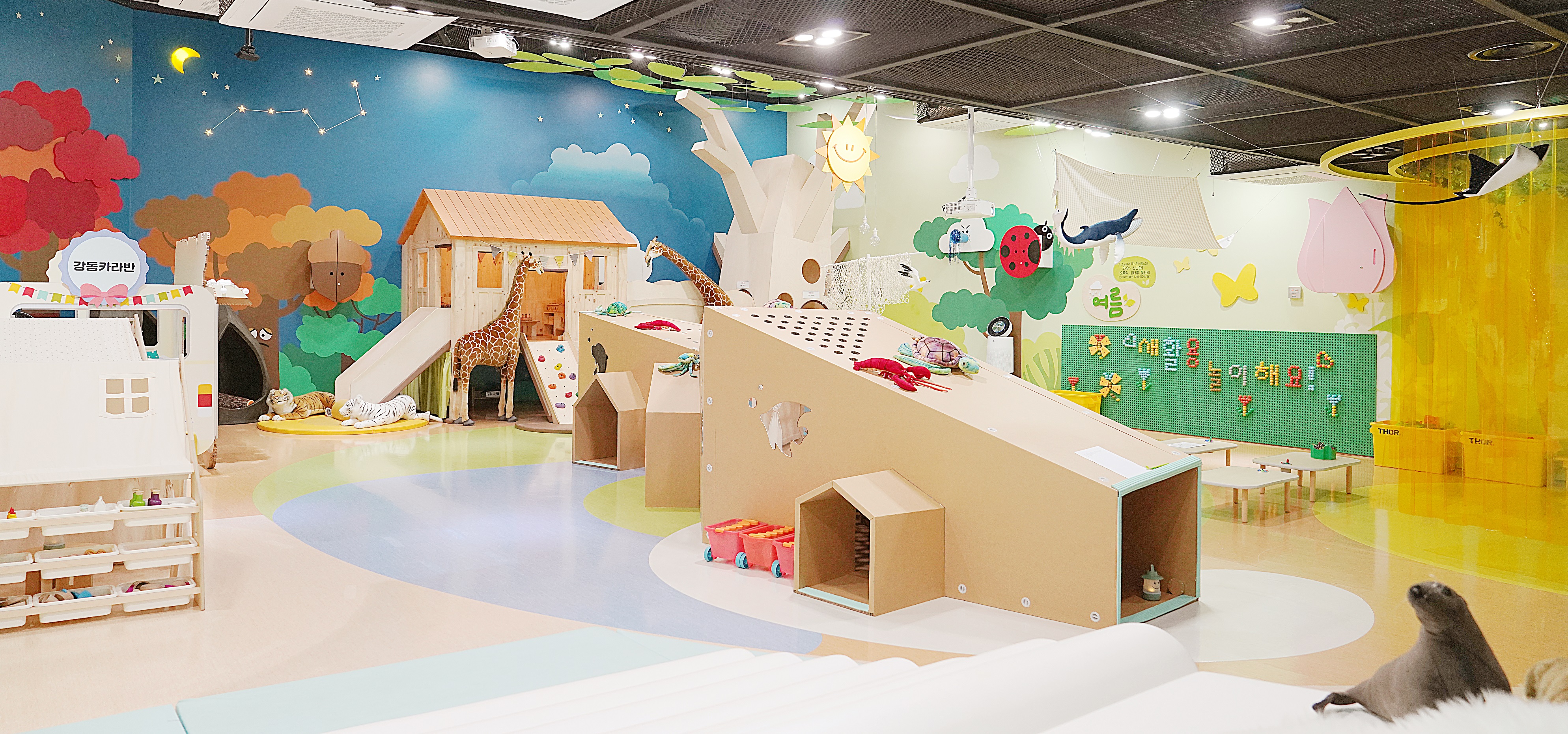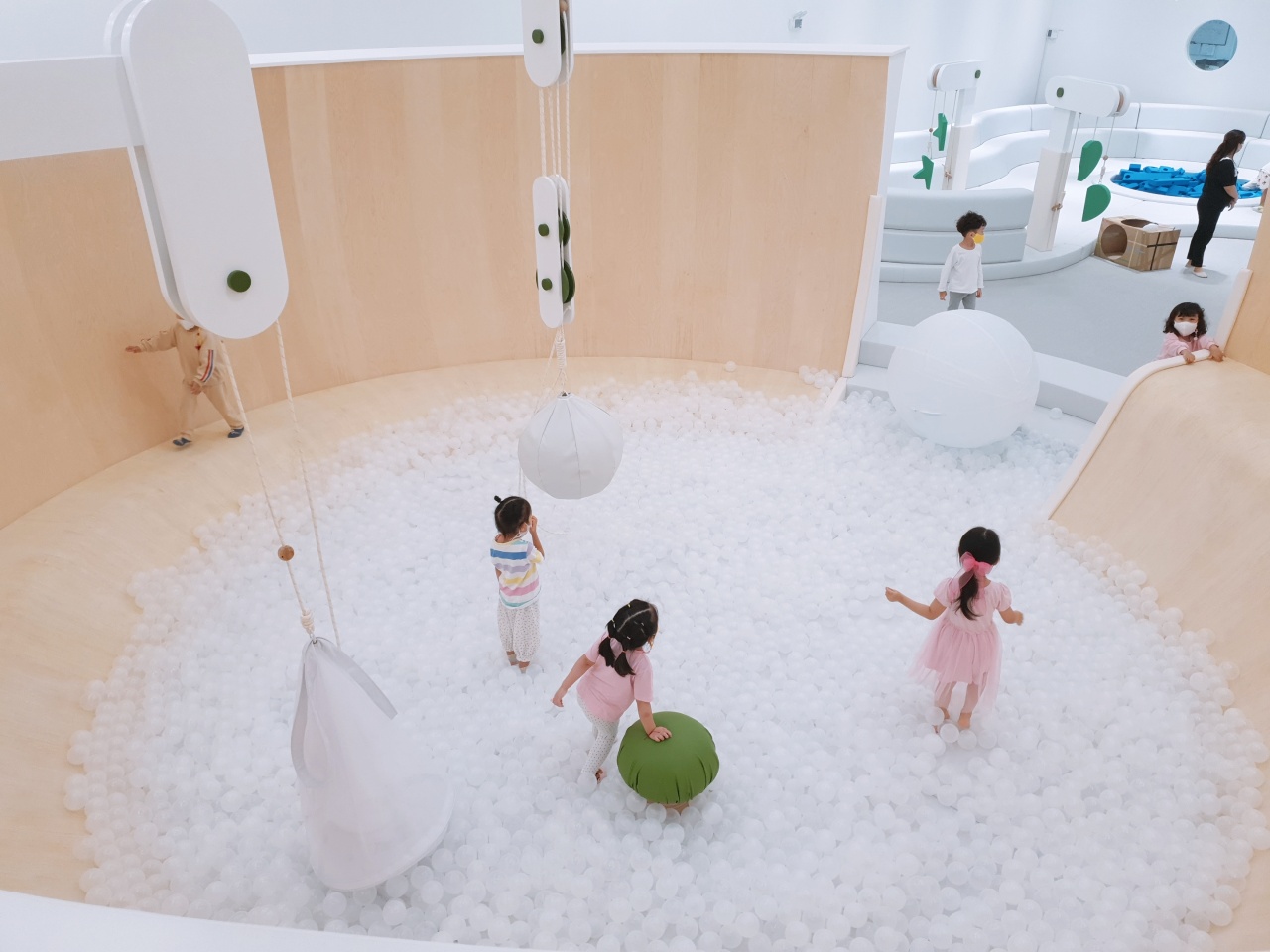[Feb] Local governments hope new play sites make parenting easier
Date Feb 20, 2023
 Dongdong e-Nature Playground inside the Gangdong Children Center, a kids’ café-like facility run by the Gangdong-gu Office in eastern Seoul (Courtesy of Gangdong-gu Office)
Dongdong e-Nature Playground inside the Gangdong Children Center, a kids’ café-like facility run by the Gangdong-gu Office in eastern Seoul (Courtesy of Gangdong-gu Office)
Korea’s birth rate is one of the lowest in the world. The nation’s total fertility rate, the average number of babies a woman bears between the ages of 15 and 49, has stayed below 1 and consistently fallen since registering 0.98 in 2018. It was 0.92 in 2019, 0.84 in 2020 and 0.81 in 2021.
Reasons given for the declining birth rate include the high youth unemployment rate, exorbitant housing prices and a social environment that is not conducive to raising children. One example of the latter is the insufficient number of public facilities or places where children can play safely. More and more high-rise buildings and heavy traffic have led to fewer and fewer playgrounds.
There are privately operated indoor places called “kids’ cafés” that provide various toys, playrooms, games and rides. But frequent visits to these private venues can get pricey – admission fees run between 10,000 won and 30,000 won per hour per child, depending on the facilities, with each guardian required to pay around 5,000 won, and that’s even before the cost of the food and beverages.
To resolve this situation, local governments are setting up their own kids café-like facilities where children can play and mingle with peers, while parents exchange child-rearing tips. Those facilities are offered free of charge or with low entry fees – mostly under 5,000 won per child for one to two hours – with discounts available to the residents of the relevant municipal district.
The Gangdong-gu Office in eastern Seoul operates Dongdong e-Nature Playground, an indoor facility for children five years old or younger.
Located inside the Gangdong Children Center, the playground has slides, ball pools, tree houses, a section to play house and more. They are in four season-themed areas: spring, summer, fall and winter.
Special programs are added around such holidays as Seollal, or Lunar New Year, so the children can play games like the traditional board game yutnori.
 Dorrr, a playground run by Namyangju Support Center for Children in Namyangju, Gyeonggi-do Province, offers a chance for children to try pulleys and learn about how they work. (Courtesy of the City of Namyangju)
Dorrr, a playground run by Namyangju Support Center for Children in Namyangju, Gyeonggi-do Province, offers a chance for children to try pulleys and learn about how they work. (Courtesy of the City of Namyangju)
Some local governments infuse their facilities for children with unique local features and history.
There is a distinct pulley motif at Dorrr, an indoor playground run by Namyangju Support Center for Children in Namyangju, Gyeonggi-do Province.
Why pulleys? Namyangju is the birthplace of Jeong Yak-yong (1762-1836), a Joseon Dynasty government official and scholar whose pen name was Dasan. The region has many places commemorating him: the house where he was born, his tomb, a museum introducing his achievements.
One of Jeong’s achievements was the development of the lever-and-pulley crane (geojunggi) that was used to lift heavy stones during the construction of the Hwaseong Fortress in Suwon, Gyeonggi-do.
To mark this achievement, Dorrr encourages children to learn the mechanics of pulleys through hands-on experience. The facility’s name also comes from the sound of something rolling and is similar to the Korean word for pulley doreurae.
The three-story building offers not only the playground but also various art and culture programs featuring picture books, musical instruments and puppet shows.
There are also outdoor venues with a focus on playing in nature.
Jeonju in Jeollabuk-do Province operates dozens of outdoor playgrounds, mostly in wooded areas. There, children can use their creativity while playing among and with natural objects such as trees, leaves, rocks and puddles.
Even though slides, swings and other standard playground equipment can also be found in these places, children have different experiences than they would have playing on them in city playgrounds since this equipment comes in unusual shapes and is made of wood.

The Ministry of Culture, Sports and Tourism's "Korea Here & Now" work can be used under the condition of "Public Nuri Type 1 (Source Indication)."




